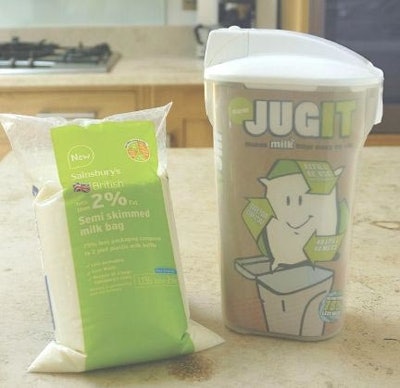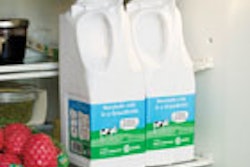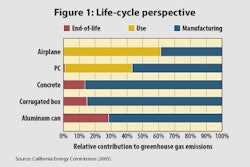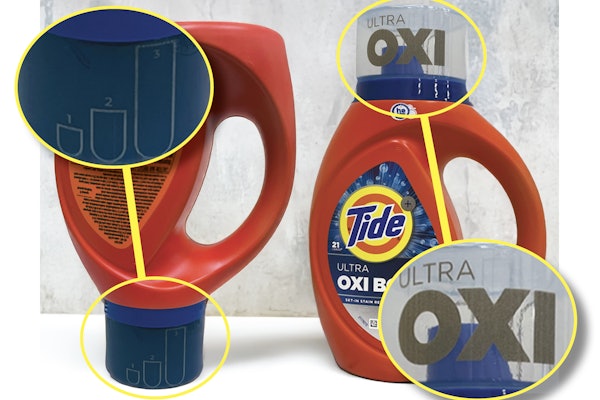
Earlier this summer, the U.K.’s Food and Farming minister, Lord Rooker, called for the country's dairy industry to become more sustainable, targeting a 50% reduction in the amount of plastics used in milk packaging as a key goal for 2020. That means even more growth for greener packaging in a country that has already shown innovative diversity, as the following examples indicate.
• Sainsbury’s debuted JUGIT from Dairy Crest, a plastic pouch of milk used in conjunction with a specialized reusable jug. The jug is manufactured by RPC Market Rasen (www.rpc-marketrasen.co.uk ). The jug’s two-piece lid features a hollow-spike attachment, which perforates the pouch when closed. The top of the attachment flips open to provide a handy, recloseable spout.
• Suffolk-based Marybelle dairy in fall 2008 began to sell its semi-skimmed milk in ASDA stores in eastern England in “GreenBottles” from GreenBottle Ltd. (www.greenbottle.com). GreenBottle replaces conventional high-density polyethylene milk bottles with bottles molded from recycled office paper and low-density plastic liners. ASDA’s Chris Brown says “Milk is one of our highest-selling products, and as such, we have a responsibility to develop alternative packaging making it easier for our customers to go green and to help them recycle at home. The GreenBottle is robust, practical, and fit for [this] purpose.”
A Life Cycle Assessment (LCA) for GreenBottle completed by consultancy Pira Intl. (www.piranet.com) found that the carbon footprint of GreenBottle was 48% lower than the HDPE milk bottle.
The view from the U.S.
Packaging consultant Sterling Anthony (www.pkgconsultant.com) says this market is being "milked" as part of an ongoing, tried-and-true progression:
1. Begin with a product characteristic (pourable liquid);
2. Select a major category (milk);
3. Eventually extend to other categories that have similar characteristics (juices, smoothies, oils, etc.).
Anthony is not optimistic about the market potential for the GreenBottle or JUGIT formats stateside. "For one thing, we lack the regulatory mandates that exist in the U.K.," he says. "For another, Americans might be resistant to having to make an extra purchase–the jug—even though it's reusable.
"Finally, U.S. consumers value the convenience of being able to see the contents, which is not present with the GreenBottle. It's also debatable whether the majority of milk buyers would be willing to separate the outer paper pulp casing from the film bag, assuming the availability of recycling/composting facilities."
That's not to say that U.S. dairies have soured on more efficient packaging. "The square gallon plastic container used by the Member's Mark brand of Sam's Club improves cube utilization," Anthony points out. The square milk container is also used by Costco's Kirkland brand.
To hear more about sustainable packaging initiatives in the U.K. and Europe, see the podcast, Packaging and sustainability: The view from the U.K. http://www.packworld.com/podcast-26527
• Sainsbury’s debuted JUGIT from Dairy Crest, a plastic pouch of milk used in conjunction with a specialized reusable jug. The jug is manufactured by RPC Market Rasen (www.rpc-marketrasen.co.uk ). The jug’s two-piece lid features a hollow-spike attachment, which perforates the pouch when closed. The top of the attachment flips open to provide a handy, recloseable spout.
• Suffolk-based Marybelle dairy in fall 2008 began to sell its semi-skimmed milk in ASDA stores in eastern England in “GreenBottles” from GreenBottle Ltd. (www.greenbottle.com). GreenBottle replaces conventional high-density polyethylene milk bottles with bottles molded from recycled office paper and low-density plastic liners. ASDA’s Chris Brown says “Milk is one of our highest-selling products, and as such, we have a responsibility to develop alternative packaging making it easier for our customers to go green and to help them recycle at home. The GreenBottle is robust, practical, and fit for [this] purpose.”
A Life Cycle Assessment (LCA) for GreenBottle completed by consultancy Pira Intl. (www.piranet.com) found that the carbon footprint of GreenBottle was 48% lower than the HDPE milk bottle.
The view from the U.S.
Packaging consultant Sterling Anthony (www.pkgconsultant.com) says this market is being "milked" as part of an ongoing, tried-and-true progression:
1. Begin with a product characteristic (pourable liquid);
2. Select a major category (milk);
3. Eventually extend to other categories that have similar characteristics (juices, smoothies, oils, etc.).
Anthony is not optimistic about the market potential for the GreenBottle or JUGIT formats stateside. "For one thing, we lack the regulatory mandates that exist in the U.K.," he says. "For another, Americans might be resistant to having to make an extra purchase–the jug—even though it's reusable.
"Finally, U.S. consumers value the convenience of being able to see the contents, which is not present with the GreenBottle. It's also debatable whether the majority of milk buyers would be willing to separate the outer paper pulp casing from the film bag, assuming the availability of recycling/composting facilities."
That's not to say that U.S. dairies have soured on more efficient packaging. "The square gallon plastic container used by the Member's Mark brand of Sam's Club improves cube utilization," Anthony points out. The square milk container is also used by Costco's Kirkland brand.
To hear more about sustainable packaging initiatives in the U.K. and Europe, see the podcast, Packaging and sustainability: The view from the U.K. http://www.packworld.com/podcast-26527
Companies in this article
Videos from Greener Corporation
























